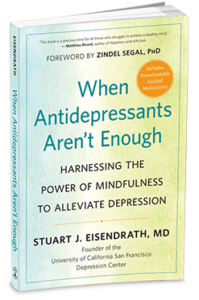There is a very good chance that if you suffer from depression you may have a coexisting problem like an anxiety disorder. In our research of individuals with depression, 75% of them had a coexisting anxiety disorder. This makes sense in that both depression and anxiety have a relationship to your sense of focus on time. For example, in depression, you are probably focused on a loss (e.g. a relationship, position, money) that has already occurred. In anxiety disorders, you are focused on an upcoming loss that you anticipate occurring.
Time Focus
This relationship to time focus highlights one of the ways that MBCT helps: it brings your focus to the present moment, letting go of looking at the past or the future. If you are focused on your breath in this moment, you cannot be focused on past losses or future catastrophes. The focus on the present represents one of MBCT’s transdiagnostic features. This term, transdiagnostic, means that MBCT works with a variety of conditions. Although it was originally developed to prevent depression relapse, its use has broadened as researchers have probed its utility with other conditions. Conditions where MBCT has been successful include anxiety disorders, insomnia, headache, gastrointestinal disorders, tinnitus, somatoform disorders, ADHD, OCD, and coping with cancer. There are new applications being tested and reported monthly.
How does MBCT work in such a variety of conditions?
If you suffer from depression and one of these other disorders, there is a good chance MBCT may be helpful for both conditions. Why is this? Many of the features of the treatment appear to be useful for multiple conditions and we can examine them is some depth.
- MBCT is aimed at being aware of the present moment. This means having mindful awareness of what is happening while it is happening. We already discussed how this may help with depression and anxiety, but imagine if you suffering from cancer. Then the present moment may help keep you centered on where you are at any one point in time, without getting caught up in future imagining of disasters to come. Instead of thinking about how terrible chemotherapy will be, you can stay with the present moment and how you are feeling right now.
- Decreasing rumination. Rumination is the endless playing of tapes in your mind on a continuous loop. Sometimes people mistake it for problem-solving, but it isn’t—it doesn’t’ lead to any solutions. What it does lead to typically is recriminations and regrets. Nolen-Hoeksema has studied rumination and found that it is a driver of depression. If you can shift attention to the present moment, it helps break the cycle of rumination which in turn helps improve mood. We found this effect in our research. After 8 weeks of MBCT training, rumination levels decreased and mood improved. Decreasing rumination improves other moods like anxiety as well.
- Decentering is another important feature of MBCT. This term means you can start to see things with a somewhat removed perspective. For example, imagine yourself walking down a street lined with shops displaying various items, namely thoughts and feelings. Instead of going into the stores and buying (accepting) the thoughts and feelings as if you own them, you can keep walking down the street and let the awareness of the items fade. In this way, the items lose their grasp of you.
- Acceptance is a key ingredient of MBCT. Acceptance doesn’t mean resignation, but rather awareness. For example, accepting that you have a problem—e.g. a substance abuse problem or a relationship problem—doesn’t mean you are stuck with it forever. It does mean you are now in a position to respond more skillfully to than if you were keeping it out of awareness.
- Self-compassion is another important component of MBCT. Usually in depression and other disorders, we hold onto self-critical views of ourselves. We aren’t smart enough, pretty enough, wealthy enough, or some other criteria to beat ourselves up with. With MBCT you learn to shift towards being more compassionate to ourselves. For example, if I make a mistake, I could replace “how stupid I am” with how much in common I have with everyone else who makes mistakes—it’s part of my common humanity.
- Awareness of the body is an important aspect of mindful attention. How often do we pay attention to our breath sensations? How often do we notice the amazing movement taking place in our legs and feet as we walk? As we become aware of bodily sensations we can begin to notice how our emotions are held in the body. What does depression, anxiety, or anger feel like in the body? Can we loosen the tightness that we may be holding? Can we breathe into the body parts that are holding an emotion?
These six aspects of MBCT are not the only healing factors. If you want to go deeper you may enjoy When Antidepressants Aren’t Enough: The Healing Power of Mindfulness. The book goes into greater depth than is possible here. But the six aspects do provide an understanding of how MBCT can be transdiagnostically helpful. Many of the conditions that trouble us could benefit from greater doses of these six features. The challenge is to learn the techniques that can help build these qualities into our lives. The book highlights the skill-building techniques that allow for this growth. The important takeaway from today’s discussion is that MBCT can have powerful effects on more than just our depressive problems.
